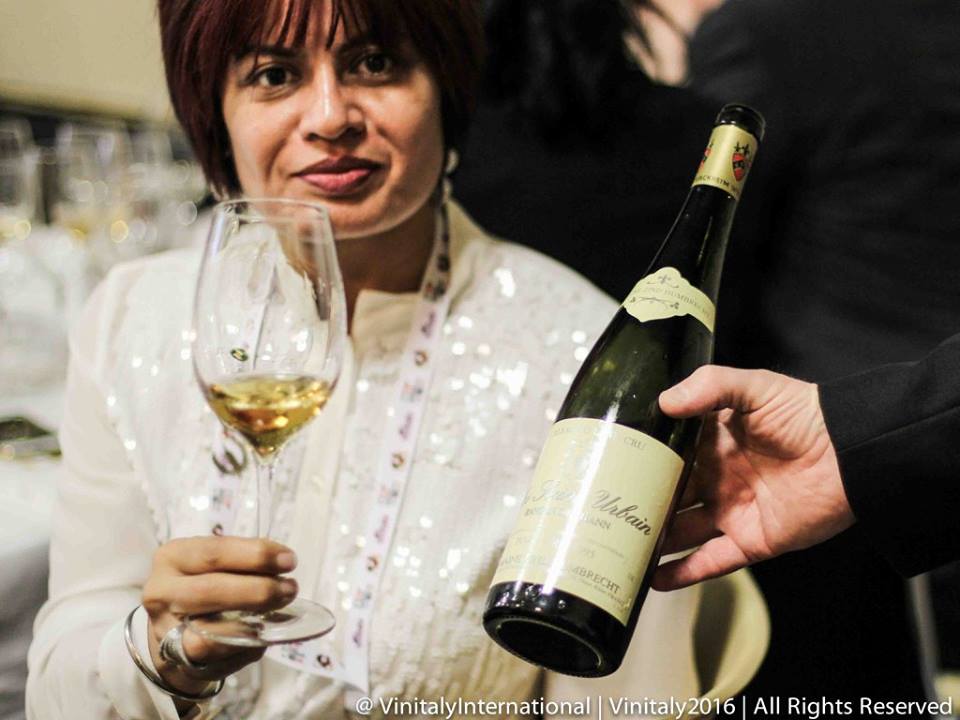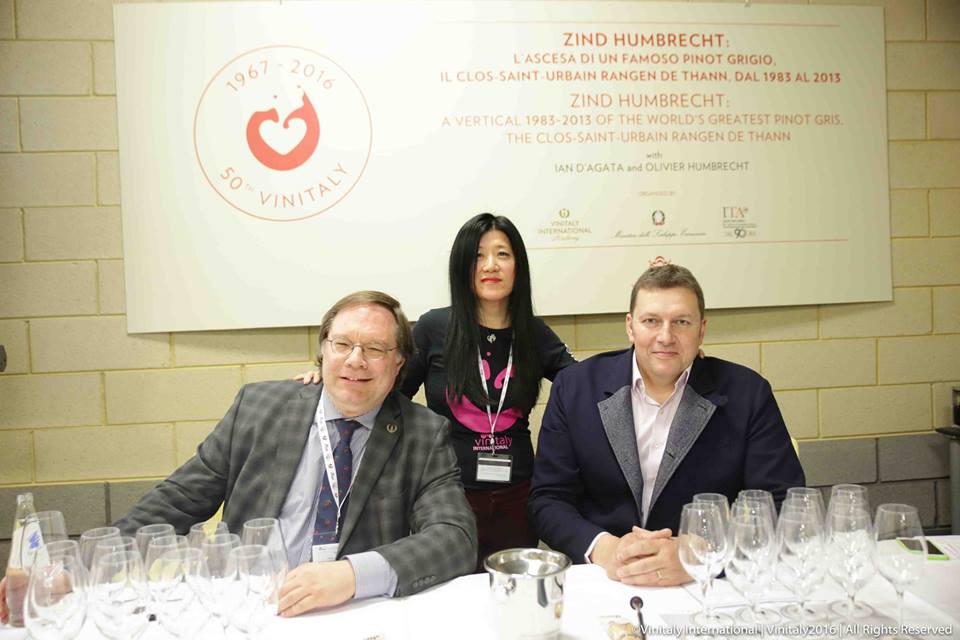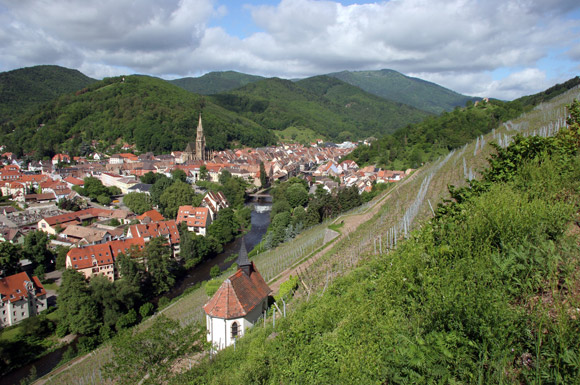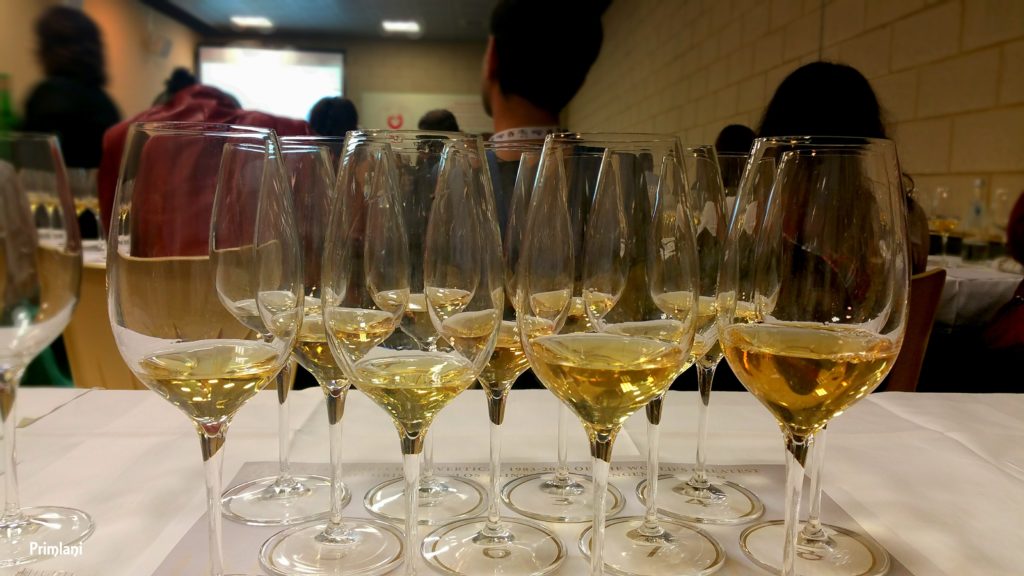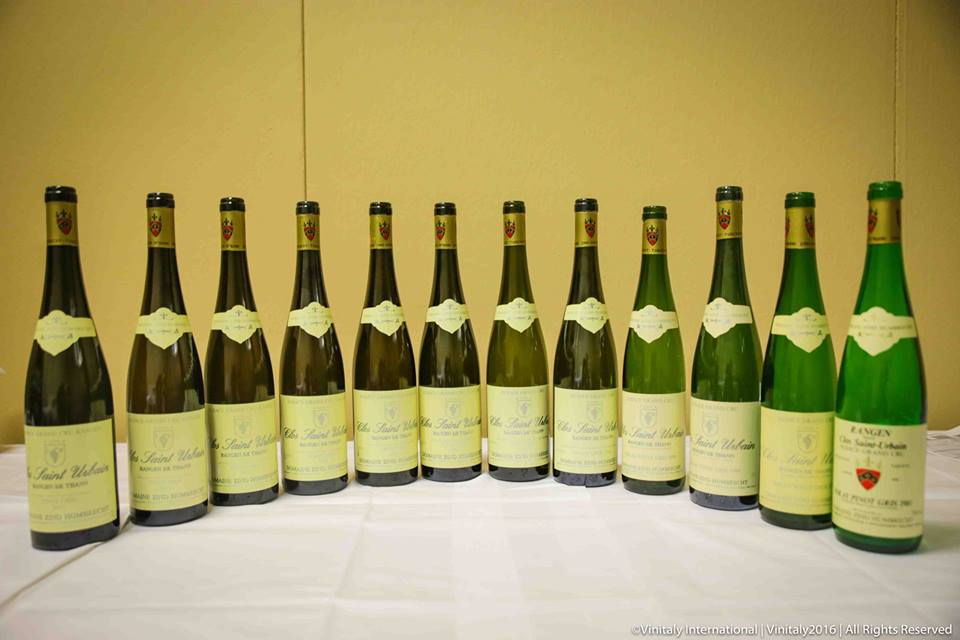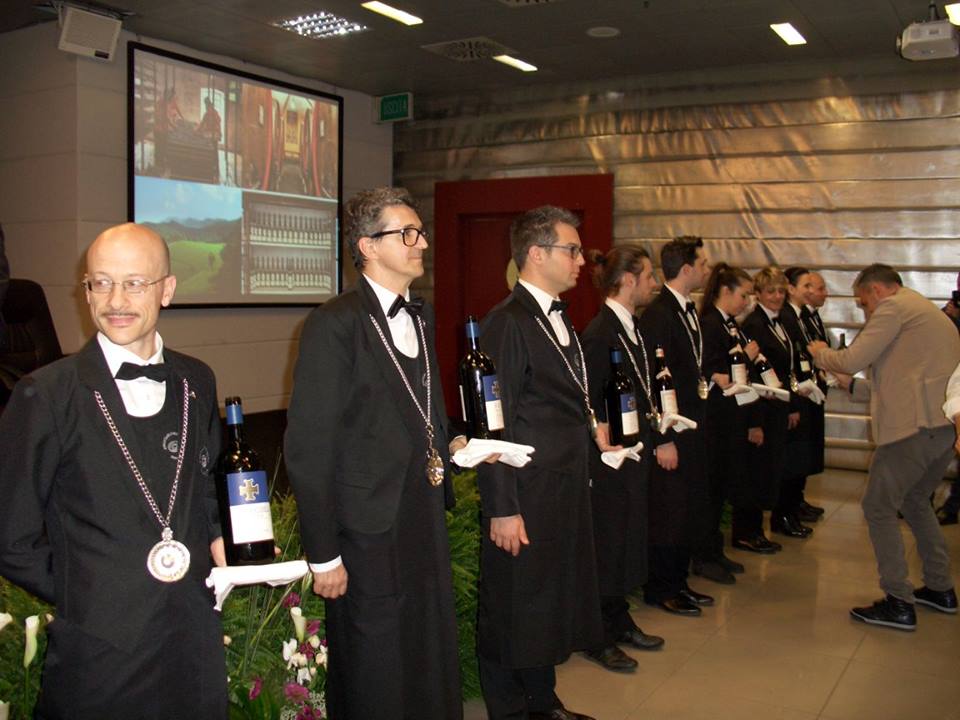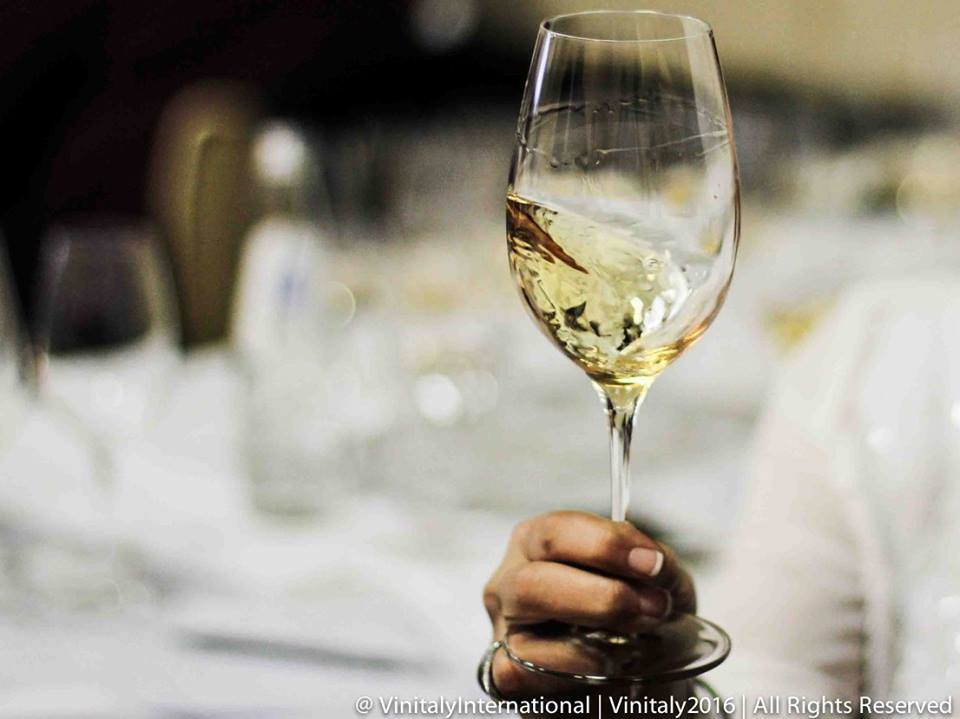Picture it: A mouthwatering maze of 100,000 square meter, 4,000+ exhibitors – a mecca for wine aficionados and industry professionals under one roof. Well technically 21 roofs (corresponding to Italy’s twenty wine regions & one international pavilion), and 150,000 visitors including 2,600 journalists from 46 different countries scattered over four days.
Amidst our marathon walking, intense speed wine tastings, and thousand handshakes, for a brief moment, time literally came to a standstill and transported a few of us lucky folks to the magical land of Alsace, France with an exclusive vertical tasting of Domaine Zind Humbrecht scintillating Pinot Gris spanning over four decades from the recent 2013 to the unforgettable 1983. Mille grazie to Ms. Kim & Dr. Igata for orchestrating this exquisite once in a life time opportunity.
Also known as Pinot Burot, Gris Cordelier, and Malvoisie in France, Ruländer and Grauer Burgunder in Germany, as Malvoisie in Switzerland, Pinot Grigio in Italy, and Szürkebarat in Hungary. Today our undivided focus is on Pinot Gris, the unsung hero of Alsatian Whites tucked between the Vosges Mountains and the Rhine, hugging the borders of Germany.
Pinot Gris along with Pinot Blanc and Pinot Meunier are nature’s mutation of the world’s greatest noble grape Pinot Noir. In my view, Pinot Gris’s ability to offer a wealth of flavors from light to rich, dry to sweet, complexity when done right, earns it as one of the world’s seductive gastronomical partners.
At the helm of our sensational guided tasting was not only the very first Frenchman to become a Master of Wine but also one of the top white wine makers in the world, Mr. Olivier Humbrecht – General Manager of their family estate dating back to 1620 Domaine Zind Humbrecht (such an honor and treat). The modest bio-dynamic vigneron who tends to his vines with a holistic approach, seeking inspiration from the cosmic sources of life has successfully translated his cerebral beliefs into mesmerizing, age-worthy wines recognized for their purity, intensity and above all expression of terroir.
I for one have only the highest regard and admiration for people who stand strong to their convictions and beliefs, choosing the more arduous and less traveled road to arrive at their destination.
Planted by the Cistercian Monks in the 11th century, today considered a Grand Cru, Clos Saint Urbain Rangen Vineyard in Thann (13.6 acres), the southernmost vineyard of Alsace’s 51 Grand Crus, boasts of rare volcanic soil dating from the Carboniferous era (Dévono-dinantien). This volcanic soil along with low yields, and green harvesting imprints a unique mineral-driven character to the Pinot Gri’s from Rangen.
Shall we taste?
Pinot Gris Clos Saint Urbain Rangen de Thann Grand Cru 2013: The distinct smoky character shines through in the late and cool 2013 vintage. Produced from 51 year old vines, discreetly demi-sec, surprisingly finishes dry and austere. I look forward to tasting this wine in another decade.
Pinot Gris Clos Saint Urbain Rangen de Thann Grand Cru 2011:Old vines produce concentrated and higher in alcohol wines. Warm and dry 2011 lead to early harvest yet the Pinot Gris finished with 15.5 alcohol producing one of the driest (5gm/l residual sugar) finishes. A rarity indeed! A bowl of succulent sweetbreads would have come in handy here.
Pinot Gris Clos Saint Urbain Rangen de Thann Grand Cru 2010: In contrast to 2011, 2010 was an ideal year for development of the prized noble rot, honey-kissed gold, spicy, intense, with a powerful long and juicy finish.
Pinot Gris Clos Saint Urbain Rangen de Thann Grand Cru 2008: A stress-free vintage similar to 2007, main concern managing the high vigor of vines, largerly due to heavy rainfall in July. Intense canopy management to the rescue. Ah, the sensual aromas of botrytis, how I love thee!! Pale gold in color, luscious ripe fruit, finishing with mouthwatering acidity, indeed a wine to enjoy for years to come.
Preparation 500 or as Zind Humbrecht calls P500 is kind of like homeopathic treatment for plants, (catalogued by founder of biodynamic approach – Austrian scholar Rudolf Steiner). Prep 500 is made by filling a cow horn with preferably lactating cow dung, burying it underground in winter. Once ready and extracted in spring, turns into dark humus. Utilizing it in minuscule portions adding it to water and spraying the soil in spring and autumn to encourage deep rooting system amongst other agricultural benefits.
P501 is made from quartz and water packed into cow horn, buried in summer for use the following spring. Utilized in pea-size quantity it promotes photosynthesis and ripening. Then there is P502 made from yarrow flowers, P503 from German chamomile, P504 from stinging nettle. (It’s an odd sight venturing on an entire bed of nettles drying in the middle of a winery. Mayasayra in Oregon of the Momtazi family, Demeter Certified Biodynamic®).
Yes, it sounds bizarre employing animal remains. Food for thought – Carrying on the century old tradition of utilizing all parts of an animal, nothing goes waste, inspiring recycling, does it sound so implausible?
Pinot Gris Clos Saint Urbain Rangen de Thann Grand Cru 2005: A fine example of tannins in a white wine. Lingering spicy nose, firm structure, and saline finish.
Moving 2005 onwards, Olivier Humbrecht’s stylistic choice of resting his wines on their lees for at least one year before bottling assists in releasing additional flavor compounds and rounding the mouthfeel, in turn creating wines of depth and complexity.
Pinot Gris Clos Saint Urbain Rangen de Thann Grand Cru 2001: Rich, luscious, concentrated aromas of ginger, spice, smoke, honey, candied apricots, marvelously round, lingering finish. One word sums up the experience – seductive.
Pinot Gris Clos Saint Urbain Rangen de Thann Grand Cru 1997: Shimmering gold color, savory tertiary notes of mushroom, bone-dry finish. Even at 19 years of age, the precision and purity of acidity shines through.
Pinot Gris Clos Saint Urbain Rangen de Thann Grand Cru 1995: Smallest vintage on record due to rot. Ripe fruit with just the right amount of sugar, a bit high in alcohol for my personal liking.
Pinot Gris Clos Saint Urbain Rangen de Thann Grand Cru 1990: Note the labels from 1990 and older vintages displayed Tokay Pinot Gris (name no longer allowed as it refers to the famous Hungarian sweet wine Tokay). A unanimous favorite, the 1990 pinot gris dazzled with complexity, peaty, spicy, dry finish, terroir-driven. A wonderful year for profound, long-lived wines.
Pinot Gris Clos Saint Urbain Rangen de Thann Grand Cru 1989: Utterly intoxicating notes of truffles, terpenes, subdued fruit, but the sheer balance of acid and tannins, incontestably, a personal favorite. White wine doesn’t get more ethereal than this.
Pinot Gris Clos Saint Urbain Rangen de Thann Grand Cru 1985: A rough vintage resulting in outbreak of coulure. Noticeable tertiary aromas of mushroom and earth followed with a dry finish. 1985s illustrate the unique terroir of Rangen more so than the varietal.
Pinot Gris Clos Saint Urbain Rangen de Thann Grand Cru 1983: Still singing, this 1983 gem exemplifies the longevity of Alsatian dazzling whites and as intriguing as the magnificent white Burgundies.
Like a synchronized symphony, the sommelier’s from Association of Italian Sommelier poured Zind Humbrecht rare treasures with military precision and grace of an elegant ballerina. Elevating our exquisite tasting with old-world charm and romanticism. Bellissimo!!
In Olivier’s words ” Minerality is the ultimate interesting measurement in a wine. It cannot be faked and it is the direct influence of a place on the style of a wine. The taste of minerals is something delicate, that can be hidden or altered with various winemaking techniques, but respectful wine making will always allow the soil to influence a wine. Minerality is what makes the difference between a technological product and the result of a skillful art and a unique product: a wine from a great origin.
Domaine Zind Humbrecht’s transcending thirty year tasting rekindled our position – Alsatian white wines are worthy rivals to white Burgundies. And Pinot Gris’s balance of vibrant acidity and pure intensity of fruit allows Pinot Gris to be paired with a wide spectrum of cuisines.
White wines electric in nature, screaming terroir tug at my wanting heart. Especially ones lower in alcohol, higher in acidity, less fruit-driven, and more mineral focused.
Do yourselves a favor, pick a bottle of Alsace Pinot Gris at your local wine shop and like me fall in love all over again with the ravishing white wines of Alsace.
